|

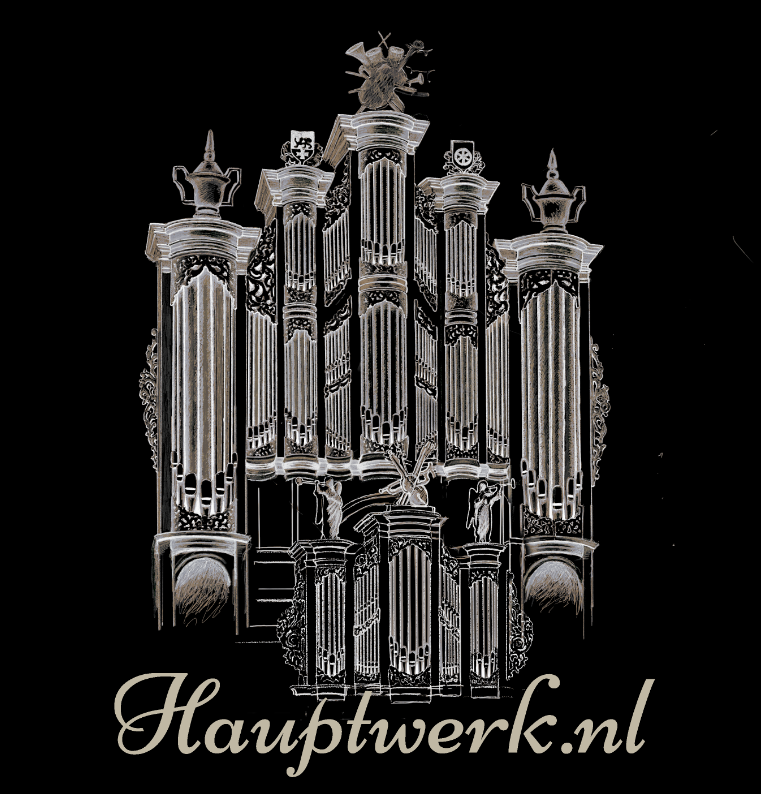








|
About the church in Móstoles, the organ and its builder.
|
History of the church in Móstoles.
Where the church now stands, a mosque once stood; a drawing of this has survived.
The oldest parts date from the ninth century. Around 1550 this church already existed, probably as remnants of the mosque and Roman remnants.
In the late 17th century, the church consisted of a central nave and two side aisles. At that time, the church possessed an organ with 21
different stops dating back to around 1550. At this time, a new northerly section, consisting of a sacristy and two side chapels,
was built. Furthermore, in the 18th century one of the chapels was enlarged.
From 1808 to 1836, the church retained the the same form. In the period from 1850 to 1852, the south side of the church was altered to create,
amongst other things, a baptismal chapel.
In 1936 (during the Spanish civil war) the church was heavily damaged and all the furnishings were destroyed.
Stories about the destruction are virtually nonexistent. A painting by the well known painter El Greco apparently disappeared
during this time.
|
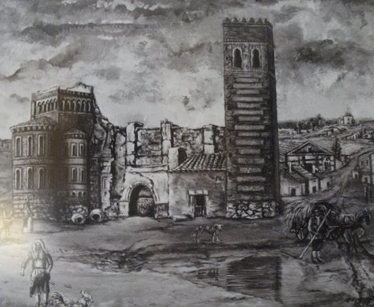
The mosque in the middle ages
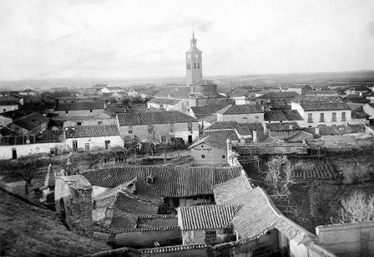
Móstoles in 1908
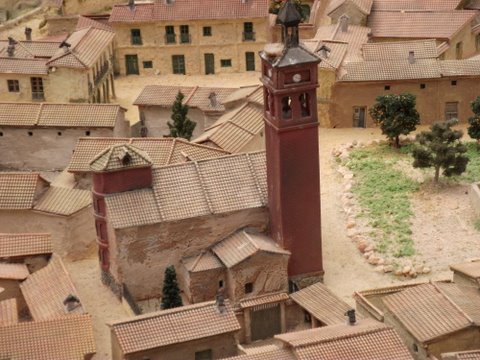
Church with nave and two side naves
|
In 1942, the church was repaired and rebuilt by the city's architect, Garcio Pables. The walls were greatly altered and the old apse
of 1200 became a sacristy. The two stories of the old apse were then removed. In 1954, the church was again put to use.
In 1970 the church was completely rebuilt by Aurelio Mendoza, partly as a result of the New Guidelines for the Liturgy arising from
the second Vatican Council.
Among other things, Mendoza added two semicircular facades to the existing building. The space of the old apse was reduced to a small
day chapel with a small altar and a receptacle for the reserved Eucharist (tabernacle). Meanwhile the old arches were rebuilt.
Above the church, spaces now exist for, amongst other things, social purposes. The current altar (altar de Soledad) was constructed by
D. Riego Rojo in 1576. The main altar from the 19th century is gilded and has four beautiful paintings and some modern carving.
Seen from the perspective of today, the rebuild is controversial in that many of the old historical sections were simply removed.
Inside the church are many paintings from mostly unknown masters, but one of them, Adoracion de los Santos Reyes
(the Adoration of the Three Magi) is most probably a Rubens original!
Furthermore there is a copy of the painting representing the visage of Jesus on the cloth of Veronica by the painter El Greco.
(The original may be found in the museum of Toledo.)
Still original is a part of the apse in the Moorish style and the tower of the mosque from the 11th century where parts of a
prison cell and old arches may still be found.
In the past, this tower served as a watch tower and always stood somewhat detached from the mosque. Next to the tower was a gate
that gave access in the direction of Toledo.
In a drawing, wine vats may be seen next to the gate, this a result of viticulture in and around Móstoles at the time. Even until the
present day, there exists not a stone's throw away from the church a small street named Calle Órgano, the result of there being on
this street a tavern where the wine was cooled through a system of pipes in the form of organ pipes! ("Los Organos de Móstoles")
In the Museum of Móstoles (partially in historical Moorish style) one can still find an authentic wine cellar and a display with
three old wine vats.
In 1856 Juan de Alba wrote the first part of a comedy in two acts with music by Rogel with the title "Los Organos de Móstoles."
In 1867 a Zarzuela (operetta) in three acts, with libretto by Luis Mariano, and also titled "Los Organos de Móstoles," arose in which
the organ in Móstoles as well as the wine tavern appeared both in word and song. In 1905, master Millocker composed a comic opera
with the title "El organista de Móstoles"!
Opposite the new theatre, a fountain was built in honour of the fact that Spain has joined the EU. The architect was certainly
inspired by organ pipes! See the fountain with 12 (an octave?) metal pipes!
|
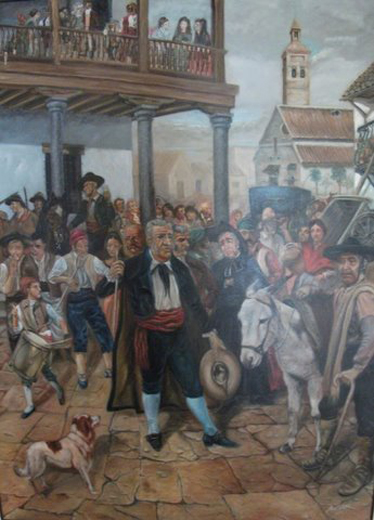
Philip II visits Móstoles
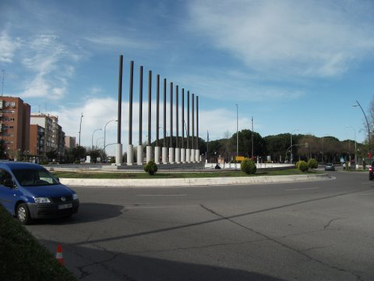
The fountain with 12 pipes
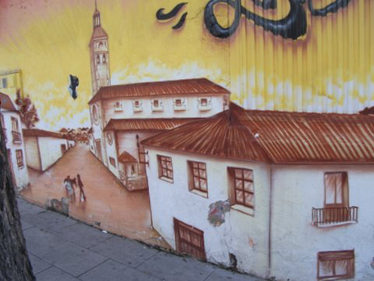
ca. 1808
|
The Organ History of Móstoles.
According to the chronicler Luis Zapata (1526-1595) the church in Móstoles already possessed an organ "the great organ in
Móstoles has 21 different stops such as flutes, regals, trumpets, a cornet, a nightingale and tremulants."
In 1550, Phillip II along with the bishop visited the organ in Móstoles and declared it to be "the most beautiful in his kingdom."
The sound especially impressed him.
In 1640 the mayor of Alcorcon wrote "the organs in Móstoles function perfectly."
The organ built in 1777 had deteriorated badly by 1816. The instrument was out of tune and essentially unplayable.
It was repaired by Ramon Sanchez in 1895 who replaced around 60 missing pipes with new ones. After that, not much is known about
the fate of this beautiful instrument. The old organ was likely lost in 1936 during the Spanish civil war.
|
The new organ in Móstoles.
With respect to form, the new organ is adapted to the current, rebuilt interior. The organ case has been treated by the
tempera technique, and profiles are gilded.
The decorations are in part derived from the altar and offering table. The organ has 21 stops as did the instrument from around 1550.
The organ is built in the classical style and is equipped with mechanical key and stop action.
The organ case is of solid wood with panels and the wind chest is made of solid oak.
The wind system consists of a wedge-bellows for Great and Pedal and a small hanging wedge-bellows with tremulant for the Brustwerk
(Organo Expresivo).
Metal pipe work has a composition of 60% tin to prevent large tuning excursions during temperature changes; in addition the pipes
are cut to length.
Stopped pipes are constructed of 75% hammered lead. The wooden pipes of the lowest octaves are made of pine and oak. The Fagot 16
pedal stop is constructed with boots and resonators of solid oak.
Of particular interest is the horizontal Trumpet with shallots of cherry wood which gives a nice round, non-metallic sound.
|
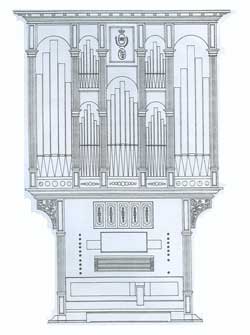
Design of the organ facade.
|
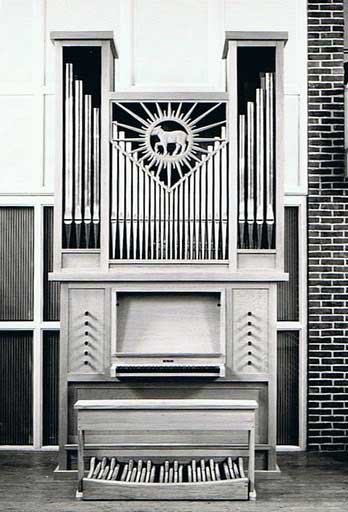
Roden NL Doopsgezinde kerk
1/M/P 6 1/2 reg.
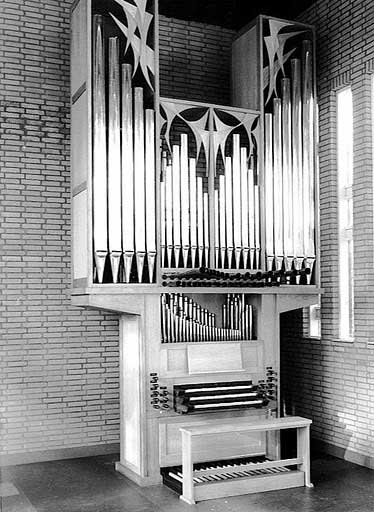
Delft NL Gereformeerde kerk
3/M/P 15 reg.
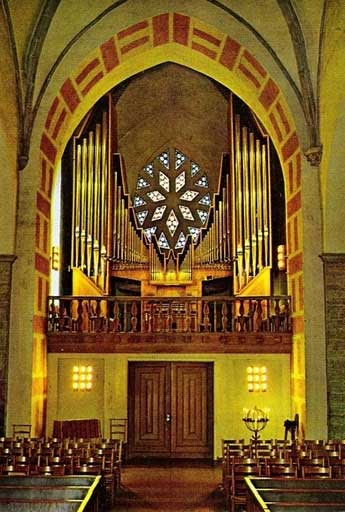
Örebro SE Nicolaikirche
3/M/P 40 reg.
|
About the builder of the new organ in Móstoles.
Eppo Rynko Ottes (born in 1941 in Groningen) has already
worked for 45 years as an organ builder and during this time has worked on new instruments, and the restoration and voicing of over
200 organs in Europe and Asia.
He is known for his subtle and artistic voicing artistry.
EXPERIENCE
Already at the age of fifteen, he and a friend visited Dutch, German and Scandinavian organs.
From the age of six, he studied piano and organ with Wim van Beek, organist at the Martinikerk in Groningen, and after that with Finn
Videro in Copenhagen.
After an apprenticeship with three Dutch organ builders and the study of more than 300 famous historic organs in Groningen and
Oost-Friesland, he started his own business in 1964 in Roden (Dr.)
Because of the lack of housing in the Netherlands, he moved to Denmark. As manager at Troels Krohn (Hillerod), and
in cooperation with Poul Gerhard Anderson and Marcussen/Kopenhagen
he completed many instruments.
After an organ builder in Germany offered him a position as head voicer and organ facade designer, he worked there for a few years
and as a free lancer he worked jointly with a variety of builders.
In 1978 he continued his own business close to the Swiss border and also worked together with international organ builders.
In 1990, he moved to Spain where he worked in conjunction with Spanish builders and under his own direction completed new
instruments and carried out (international) restorations.
New organs in Spain include, amongst others, Premia de Dalt, Torreciudad and Móstoles

Premia de Dalt E
2/M/P 10 reg.
|

Torreciudad Capella de la Guadalupe E
2/M/P 8 reg.
|
|
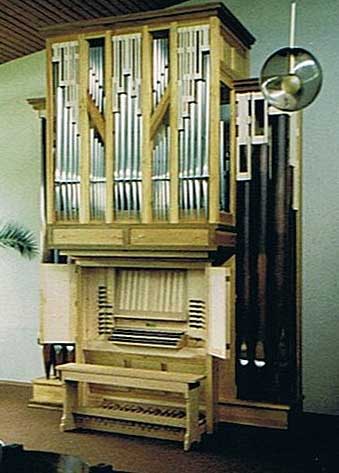
Aitrach D Reformierter Kirche
2/M/P 15 reg.
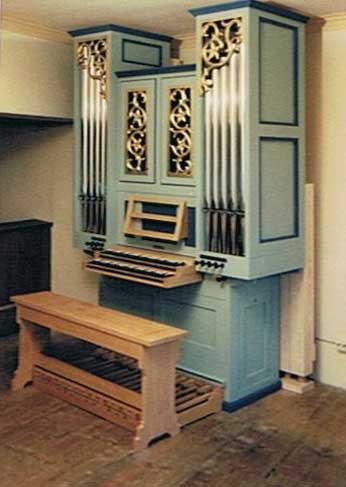
Harthausen D
2/M/P 10 reg.
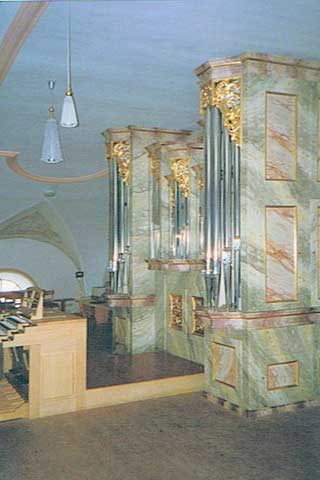
Pittenhart D
3/M/P 21 reg.
|
|
|
Hauptwerk.nl is an initiative from Sygsoft Holland. KvK 93602855. Last updated
2024-06-01
|
|
|
